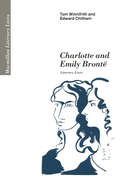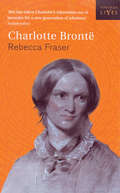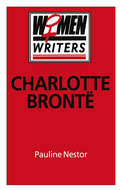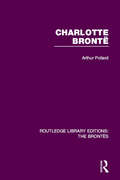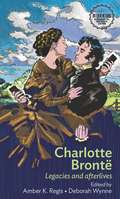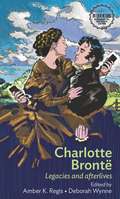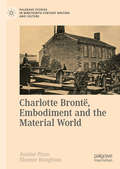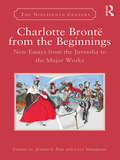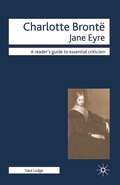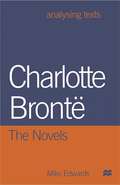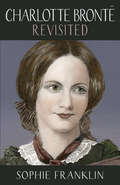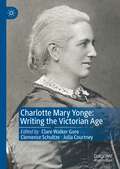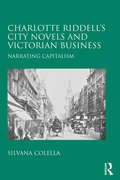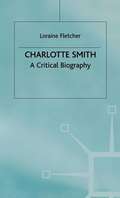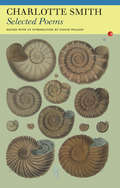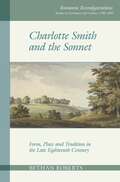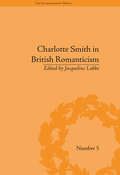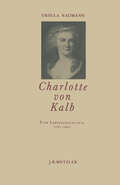- Table View
- List View
Charlotte and Emily Brontë: Literary Lives (Literary Lives)
by Edward Chitham Tom WinnifrithThis new book on the Brontes concentrates on the way in which the literary interests and expressions of Charlotte and Emily were built up. It makes use of recent research into background and reading matter to investigate the development of the authors' poetry and novels.
Charlotte Bronte: Charlotte Bronte And Her Family (Vintage Lives #3)
by Rebecca Fraser'If men could see us as we really are, they would be amazed', wrote Charlotte Brontë, the outwardly conventional parson's daughter who had rarely met any men beyond those of the church or classroom by the time Jane Eyre was published in 1847. From the landscape of the Yorkshire moors, an appalling childhood and a family decimated by consumption, Jane Eyre came as an instant literary sensation. It also brought Charlotte Brontë the notoriety that was to remain with her for the rest of her short and tragic life. Elizabeth Gaskell, Charlotte's first biographer, attempted to clear Charlotte of the charges of passionate immorality that were levelled at a woman author - and an unmarried one at that. Rebecca Fraser, 130 years later, placed Charlotte's life within the perceptual framework of contemporary attitudes to women. Her biography is an invaluable contribution to Brontë scholarship, which shares her admiration for a woman prepared to stand out against some of the cruelest Victorian ideas about her sex.
Charlotte Brontë (Routledge Library Editions: The Brontës)
by Arthur PollardWithin the narrow confines of Haworth Parsonage the Brontë children constructed a multiform fantasy world and to their gift of intense imagination was added the quality of intense passion. The narrowness of Charlotte’s experience makes autobiography important in her novels, while her imagination and passion exalt the subjectivity of her work. Her style is autobiographical also, adding credibility to the often heightened narrative, while the moralism of her heroines often serves to stabilise this exaggeration. This book, first published in 1968, introduces extracts from the novels of Charlotte Brontë, emphasising the author’s subjectivity, imagination and the resultant heightening of dialogue and experience. There is a central section on her heroines, while others discuss and illustrate events, other characters, the handling of time and place, speech and dialogue and the author’s place in novels. This title will be of interest to students of English Literature.
Charlotte Brontë (Routledge Library Editions: The Brontës)
by Arthur PollardWithin the narrow confines of Haworth Parsonage the Brontë children constructed a multiform fantasy world and to their gift of intense imagination was added the quality of intense passion. The narrowness of Charlotte’s experience makes autobiography important in her novels, while her imagination and passion exalt the subjectivity of her work. Her style is autobiographical also, adding credibility to the often heightened narrative, while the moralism of her heroines often serves to stabilise this exaggeration. This book, first published in 1968, introduces extracts from the novels of Charlotte Brontë, emphasising the author’s subjectivity, imagination and the resultant heightening of dialogue and experience. There is a central section on her heroines, while others discuss and illustrate events, other characters, the handling of time and place, speech and dialogue and the author’s place in novels. This title will be of interest to students of English Literature.
Charlotte Brontë: Legacies and afterlives (Interventions: Rethinking The Nineteenth Century Ser.)
by Amber K. Regis Deborah WynneCharlotte Brontë: legacies and afterlives is a timely reflection on the persistent fascination and creative engagement with Charlotte Brontë’s life and work. The new essays in this volume, which cover the period from Brontë’s first publication to the twenty-first century, explain why her work has endured in so many different forms and contexts. This book brings the story of Charlotte Brontë’s legacy up to date, analysing the intriguing afterlives of characters such as Jane Eyre and Rochester in neo-Victorian fiction, cinema, television, the stage and, more recently, on the web. Taking a fresh look at 150 years of engagement with one of the best-loved novelists of the Victorian period, from obituaries to vlogs, from stage to screen, from novels to erotic makeovers, this book reveals the author’s diverse and intriguing legacy. Engagingly written and illustrated, the book will appeal to both scholars and general readers.
Charlotte Brontë: Legacies and afterlives (Interventions: Rethinking The Nineteenth Century Ser.)
by Amber K. Regis Deborah WynneCharlotte Brontë: legacies and afterlives is a timely reflection on the persistent fascination and creative engagement with Charlotte Brontë’s life and work. The new essays in this volume, which cover the period from Brontë’s first publication to the twenty-first century, explain why her work has endured in so many different forms and contexts. This book brings the story of Charlotte Brontë’s legacy up to date, analysing the intriguing afterlives of characters such as Jane Eyre and Rochester in neo-Victorian fiction, cinema, television, the stage and, more recently, on the web. Taking a fresh look at 150 years of engagement with one of the best-loved novelists of the Victorian period, from obituaries to vlogs, from stage to screen, from novels to erotic makeovers, this book reveals the author’s diverse and intriguing legacy. Engagingly written and illustrated, the book will appeal to both scholars and general readers.
Charlotte Brontë and Contagion: Myths, Memes, and the Politics of Infection (Palgrave Studies in Literature, Science and Medicine)
by Jo WaughThis book argues for the significance of contagious disease in critical and biographical assessment of Charlotte Brontë’s work. Waugh argues that contagion, infection, and quarantining strategies are central themes in Jane Eyre (1847), Shirley (1849), and Villette (1853). This book establishes the ways in which Charlotte Brontë was closely engaged with the political and social contexts in which she wrote, extending this to the representation and metaphorical import of illness in Brontë’s novels. Waugh also posits that although miasmatic theories are often assumed to have been entirely in the ascendant in the late 1840s, the relationship between miasma and contagion was a complex one and contagion in fact remained a crucial way for Charlotte Brontë to represent disease itself, as well as to explore the relationships between the individual and social, political, and cultural contexts. Contagion and its metaphors are central to Charlotte Brontë’s construction of subjectivity and of the responsibilities of the individual and the group.
Charlotte Brontë, Embodiment and the Material World (Palgrave Studies in Nineteenth-Century Writing and Culture)
by Justine Pizzo Eleanor HoughtonComprising nine original essays by specialists in material culture, book history,literary criticism and curatorial and archival studies, this co-edited volumeaddresses a wide range of Brontë’s writing—from vignettes composed during herteenage years (“The Tea Party” and “The Secret”) to completed novels (TheProfessor, Jane Eyre, Shirley and Villette) and unfinished works (“Ashworth” and“Emma”). In bringing to life the surprising array of embodied experiences thatshaped Brontë’s creative practice (from writing to book-making, painting, anddrawing), Charlotte Brontë, Embodiment and the Material World forges newconnections between historical, material, and textual approaches to the author’swork.
Charlotte Brontë from the Beginnings: New Essays from the Juvenilia to the Major Works (The Nineteenth Century Series)
by Judith E. Pike Lucy MorrisonComposed of serialized works, poems, short tales, and novellas, Charlotte Brontë's juvenilia merit serious scholarly attention as revelatory works in and of themselves as well as for what they tell us about the development of Brontë as a writer. This timely collection attends to both critical strands, positioning Brontë as an author whose career encompassed the Romantic and Victorian eras and delving into the developing nineteenth century's literary concerns as well as the growth of the writer's mind. As the contributors show, Brontë's authorship took shape among the pages of her juvenilia, as figures from Brontë's childhood experience of the world such as Wellington and Napoleon transmuted to her fictional pages, while her siblings' works and worlds both overlapped with and extended beyond her own.
Charlotte Brontë from the Beginnings: New Essays from the Juvenilia to the Major Works (The Nineteenth Century Series)
by Judith E. Pike Lucy MorrisonComposed of serialized works, poems, short tales, and novellas, Charlotte Brontë's juvenilia merit serious scholarly attention as revelatory works in and of themselves as well as for what they tell us about the development of Brontë as a writer. This timely collection attends to both critical strands, positioning Brontë as an author whose career encompassed the Romantic and Victorian eras and delving into the developing nineteenth century's literary concerns as well as the growth of the writer's mind. As the contributors show, Brontë's authorship took shape among the pages of her juvenilia, as figures from Brontë's childhood experience of the world such as Wellington and Napoleon transmuted to her fictional pages, while her siblings' works and worlds both overlapped with and extended beyond her own.
Charlotte Bronte - Jane Eyre (Readers' Guides to Essential Criticism)
by Sara LodgeSara Lodge offers a lively introduction to the critical history of one of the most widely-studied nineteenth-century novels, from the first reviews through to present day responses. The Guide also includes sections devoted to feminist, Marxist and postcolonial criticism of Jane Eyre, as well as analysis of recent developments.
Charlotte Bronte - Jane Eyre (Readers' Guides to Essential Criticism)
by Sara LodgeSara Lodge offers a lively introduction to the critical history of one of the most widely-studied nineteenth-century novels, from the first reviews through to present day responses. The Guide also includes sections devoted to feminist, Marxist and postcolonial criticism of Jane Eyre, as well as analysis of recent developments.
Charlotte Bronte: The Novels (Analysing Texts)
by Mike EdwardsA practical approach to Charlotte Brontë's best- known novels, which shows how coherent criticism can be evolved from close reading. The intention is to help students develop skills in practical criticism and encourage them to follow through their ideas. The major part of the book contains worked examples, with detailed guidance and suggestions for further work which will be useful for both teachers and students. There is additional material on Brontë's background, and on critical views of her work. The novels covered are Jane Eyre, Shirley and Vilette.
Charlotte Brontë Revisited: A View From The 21st Century
by Sophie FranklinEverybody knows Charlotte Brontë. World-famous for her novel Jane Eyre, she’s a giant of literature and has been written about in reverential tones in scores of textbooks over the years. But what do we really know about Charlotte? Charlotte Brontë Revisited looks at Charlotte through 21st-century eyes. Discover her private world of convention, rebellion and imagination, and how they shaped her life, writing and obsessions – including the paranormal, nature, feminism and politics. It’s a celebration of all things Charlotte Brontë, and emphatically shows why she’s as relevant today as she ever was.'Interweaves biography and reference to scholarly material with [Franklin's] own take on pertinent aspects of Charlotte's oeuvre ... [Her] witty tone makes the calibration of these two things — the pleasure of the literary enthusiastic and the scholarly — both easy and enjoyable. Franklin deftly mixes contemporary humour with reflectivity ... superbly written, exuberant.' Brontë Studies Journal
Charlotte Mary Yonge: Writing the Victorian Age
by Clare Walker Gore Clemence Schultze Julia CourtneyThis interdisciplinary collection of essays explores the life and work of Charlotte M. Yonge, a highly influential and popular nineteenth-century writer who is emerging from a long period of critical neglect. Its wide-ranging chapters capture the scope and quality of current work in Yonge studies, addressing the full range of her prolific literary output from her best-selling novels to her nature writing, biographies, and letters. Considering themes from gender, disability, and empire, to Tractarianism, secularism, and the idea of progress, these essays consider how Yonge reflected and shaped the tastes, ideas and anxieties of her readers and contemporaries. Exploring her key role in the Anglican revival, her importance as a test case in the development of feminist criticism, and her formal innovativeness as a novelist, this collection places Yonge centrally in the nineteenth-century literary landscape and demonstrates her ongoing relevance to scholars and students of the period.
Charlotte Riddell's City Novels and Victorian Business: Narrating Capitalism
by Silvana ColellaIn spite of the popularity she enjoyed during her lifetime, Charlotte Riddell (1832-1906) has received little attention from scholars. Silvana Colella makes a strong case for the relevance of Riddell's novels as narrative experiments that shed new light on the troubled experience of Victorian capitalism. Drawing on her impressive knowledge of commerce and finance, Riddell produced several novels that narrate the fate of individuals - manufacturers, accountants, entrepreneurs, City men and their female companions - who pursue the liberal dream of self-determination in the unstable world of London business. Colella situates novels such as Too Much Alone, George Geith, The Race for Wealth, Austin Friars and The Senior Partner in the broader cultural context, examining business manuals, commercial biographies, and essays to highlight Victorian constructions of the business ideal and the changing cultural status of the City of London. Combining historicist and formalist readings, Colella charts the progression of Riddell's imaginative commitment to the business world, focusing on the author's gendered awareness of the promises and disenchantments associated with the changing dynamics of capitalist modernisation. Her book enriches our understanding of Victorian business culture, the literary history of capitalism, and the intersections of gender, genre and economics.
Charlotte Riddell's City Novels and Victorian Business: Narrating Capitalism
by Silvana ColellaIn spite of the popularity she enjoyed during her lifetime, Charlotte Riddell (1832-1906) has received little attention from scholars. Silvana Colella makes a strong case for the relevance of Riddell's novels as narrative experiments that shed new light on the troubled experience of Victorian capitalism. Drawing on her impressive knowledge of commerce and finance, Riddell produced several novels that narrate the fate of individuals - manufacturers, accountants, entrepreneurs, City men and their female companions - who pursue the liberal dream of self-determination in the unstable world of London business. Colella situates novels such as Too Much Alone, George Geith, The Race for Wealth, Austin Friars and The Senior Partner in the broader cultural context, examining business manuals, commercial biographies, and essays to highlight Victorian constructions of the business ideal and the changing cultural status of the City of London. Combining historicist and formalist readings, Colella charts the progression of Riddell's imaginative commitment to the business world, focusing on the author's gendered awareness of the promises and disenchantments associated with the changing dynamics of capitalist modernisation. Her book enriches our understanding of Victorian business culture, the literary history of capitalism, and the intersections of gender, genre and economics.
Charlotte Smith: A Critical Biography
by Loraine Fletcher'Sold, a legal prostitute' when married off at the age of fifteen, Charlotte Smith left her wastrel husband to support herself and their children as a poet and novelist who would have a lasting influence on William Wordsworth and Jane Austen. Combative and witty she became a radical, controversial and very popular author: at a time when the French Revolution was raising high hopes of Reform, she argued for change in England too. Loraine Fletcher's vivid scholarly biography is as readable for the newcomer to the 1790s as for the specialist, tracing the embattled life in the wonderfully self-dramatising fiction.
Charlotte Smith: Selected Poems
by Charlotte SmithThis book presents an ideal introduction to the full range of the works of Charlotte Smith, whose Romantic sensibility is an expression of a specifically female experience, from her influential sonnets and poems for children to extracts from her French Revolution poem.
Charlotte Smith: Selected Poems (Fyfield Bks.)
by Charlotte SmithThis book presents an ideal introduction to the full range of the works of Charlotte Smith, whose Romantic sensibility is an expression of a specifically female experience, from her influential sonnets and poems for children to extracts from her French Revolution poem.
Charlotte Smith and the Sonnet: Form, Place and Tradition in the Late Eighteenth Century (Romantic Reconfigurations: Studies in Literature and Culture 1780-1850 #9)
by Bethan RobertsAn Open Access edition of this book is available on the Liverpool University Press website and the OAPEN library.This book offers the first full-length study of Charlotte Smith’s Elegiac Sonnets and clarifies its ‘place’ – in multiple ways – in literary history as a work celebrated for ‘making it new’, yet deeply engaged with the literary past. It argues that Smith’s sonnets are constituted by three intertwined concerns: with tradition, place and the sonnet form itself, whereby the subjects of Smith’s sonnets – across birds, rivers, the sea, plants and flowers – are bound up with the literary context in which she wrote. Charlotte Smith and the Sonnet shows that Smith’s verse engages more deeply with tradition than has hitherto been realised and revises our understanding not only of Smith’s career but also of the sonnet in eighteenth-century England. The book also illuminates Smith’s place in posterity, as a popular poet – influencing figures ranging from Wordsworth and Coleridge to Constable – who was subsequently obscured in literary history. It reveals the complex processes underpinning Smith’s reception and paradoxical position from the late eighteenth century to the present day, and shows that the appropriation of place itself was an important way in which aspects of literary tradition have been negotiated and understood by Smith, her predecessors, contemporaries and successors.
Charlotte Smith in British Romanticism (The Enlightenment World)
by Jacqueline LabbeCharlotte Smith's early sonnets established the genre as a Romantic form; her novels advanced sensibility beyond its reliance on emotional facility; and her blank verse initiated one of the most familiar of Romantic verse forms. This volume draws together the best of current scholarship.
Charlotte Smith in British Romanticism (The Enlightenment World #5)
by Jacqueline LabbeCharlotte Smith's early sonnets established the genre as a Romantic form; her novels advanced sensibility beyond its reliance on emotional facility; and her blank verse initiated one of the most familiar of Romantic verse forms. This volume draws together the best of current scholarship.
